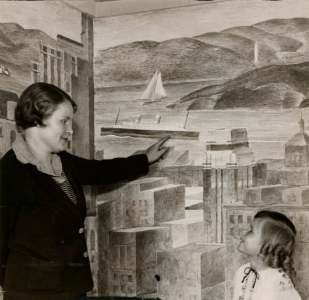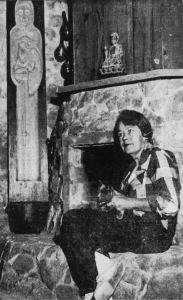

Biography
Suzanne Scheuer was born in San Jose, CA in 1898. She moved to San Francisco in 1918 and enrolled at the California College of Arts and Crafts as a fine arts major. Later in the 1920s she returned to the College of Arts and Crafts to get a teaching credential. During the 1920s Scheuer taught at public schools in Salinas and Los Banos for a period of three years. She toured Europe, gaining a strong appreciation for mural art. This led her to study mural painting with Ray Boynton at the California School of Fine Arts (later the San Francisco Art Institute) from 1929-1931. She and Boynton worked mostly in fresco and painted murals over most of the walls of the School. She also had an opportunity to meet Diego Rivera. While in school she gained experience with a few small murals, including one for a San Francisco settlement house. She did a panel in glass for a local church.
Scheuer's reputation grew as she exhibited at the San Francisco Art Association in 1925 and 1932. She joined the team of artists creating murals for the Coit Tower under the Public Works of Art Project. Being a little diffident, she deferred to John Howard on an industrial-themed mural (her preference) and was assigned the subject of newspapers. She said she knew nothing about them, but received a crash course at the San Francisco Chronicle, with a complete tour of the facility. Assisted by Hebe Daum, whom she generously described as a better artist than herself, she did complete the 12'x12' panel "Newsgathering" in 1933.
Her work in the Coit Tower led to three commissions for Post Office murals: Berkeley, CA (1937), Eastland, TX (1938), and Caldwell, TX (1939). She beat out many other artists for the Berkeley commission, but the Texas commissions were consolation prizes for competitions to paint murals in San Antonio and Dallas, respectively. While Scheuer was developing her ideas for the Berkeley mural, she worked on a WPA project, creating watercolors of the Rockaway Beach area relating to construction of the Coast Highway.
In 1938 Scheuer started working for the WPA Lithography Project. After learning the necessary technique, she created a series of lithographs of animals and their young, doing a lot of sketching at the San Francisco Zoo. These were exhibited at the Golden Gate International Exposition on Treasure Island in 1939-1940.
From 1940-1950 Scheuer taught at the College of the Pacific in Stockton. She played a small role assisting Anton Refregier in his creation of murals for the Rincon Annex Post Office in San Francisco in 1946. And she served as President of the Stockton Art League from 1944-1945.
Retiring from College of the Pacific, Scheuer moved to Santa Cruz, where she designed and built six houses. She did much of the construction work herself, particularly to create stone work and tiles. Living in Santa Cruz, Scheuer continued to paint and sculpt and to create mosaics for homes in the area. She died in Santa Cruz in 1984.


Critical Analysis
In her oral history interview with the Smithsonian, Scheuer is frankly critical of her own work in the Coit Tower. She says that she - like many of the other artists there - had never focused on the design of a large-scale piece of art. She had had no training on this topic, and she felt that "Newsgathering" was possibly too literal and too realistic for a successful work in this medium. It's true that many of the Coit Tower murals were quite busy and included (or were encumbered by) a lot of realistic detail. But this is a style that worked extremely well for Diego Rivera, and it's likely, given Scheuer's training, that this was part of her inspiration for the mural. In any case, Scheuer did include a few touches of her own. The space around the window, which necessarily intrudes upon a portion of the mural, shows the color process used to create the "Moon Mullins" comic strip. One suspects that this is one of the bits of information that Scheuer picked up in her crash course at the Chronicle. Incidentally, while the present (restored) mural in the Coit Tower has a newsboy holding up an edition of the Chronicle and a copy of the Chronicle rests on the window sill in the picture, these detail were censored out of the original mural. The Chronicle's rival, the Herald-Examiner had been printing blaring headlines about alleged Communists in the Coit Tower, and Scheuer was urged not to do anything that might further inflame the Herald-Examiner. So she labeled the papers in the mural as the "San Francisco Post." Happily, Scheuer herself was involved in the 1963 restoration of the mural, and she restored the paper's original name.
The designs for Scheuer's Post Office murals are different from her work in the Coit Tower. Her Berkeley, CA is something of a classical composition, while her two Texas murals have Native American themes and a greatly simplified design. The space allotted for the Berkeley mural was a challenge for the artist, to put it mildly. A large portion is taken up by a doorway, which Scheuer flanks with two figures. And above the doorway there is an intrusive clock, which the Postmaster refused to move. Scheuer embedded the clock in a boulder, but it still fails to add anything to the painting.
As noted in the writeup at the Postal Museum, Scheuer's Berkeley mural attempts to provide an accurate history for the origins of Berkeley. The mural involves five vignettes - the encounter of Spanish conquistadores with indigenous people, a Spanish vaquero with an indigenous woman, a white trapper, an Ohlone hunter, and a Franciscan monk. The writeup does fault Scheuer obliquely for her failure to emphasize the brutality with which the Ohlone culture was destroyed. This may be a little unfair to Scheuer, who was outspoken in her condemnation of the way whites had treated Native Americans.
Scheuer's Texas murals are, by way of contrast, directly celebratory of Native American ways. These murals abandon the style of her previous work and adopt the approach of the Kiowa Six, a group of Native Oklahoma artists who evolved a flat style of Southern Plains painting. Both of Scheuer's Texas murals are painted in this spirit, with a palette much more reserved than that of her Coit Tower or Berkeley murals. Interestingly, the Texas murals were painted in San Francisco. Scheuer first traveled to Texas when she installed the murals - and then went on for an extended stay in Mexico.
Murals
- Berkeley, California - Post Office: Incidents in California History
- San Francisco, California - Coit Tower: Newsgathering
- Caldwell, Texas - Burleson County Courthouse: Indians Moving
- Eastland, Texas - Post Office: Buffalo Hunt
References
- Biography of Suzanne Scheuer (1898-1984) (Artprice).
- Incidents in California History (Indians at the Post Office).
- Oral history interview with Suzanne Scheuer, 1964 July 29 (Archives of American Art).
- Bryan E. Wheeler, Painting Section or Painting Texas?: Negotiating Modernity and Identity in the Texas New Deal Post Office Murals (2015).
- Suzanne Scheuer (Wikipedia).
- Suzanne Scheuer (ask ART).
- Suzanne Scheuer, Santa Cruz Sentinel December 23 (1984).